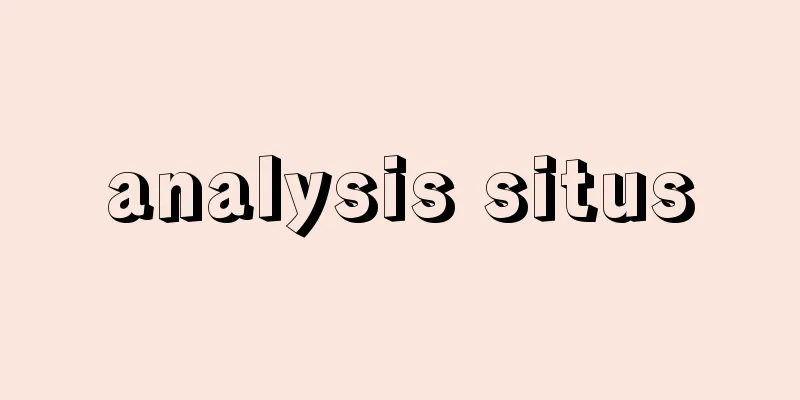Utility model - utility model (English spelling)

|
It is a synonym for the device used in the Utility Model Law, and is also called a minor invention in contrast to the invention used in the Patent Law. However, in general, there is no distinction between inventions and devices, and any creation of technical ideas that utilizes the laws of nature is usually called an invention. [Takino Hideo] Utility Model LawIt was enacted in 1905 (Meiji 38) modeled after the German Utility Model Protection Act of 1891, but earlier, Dajokan Proclamation No. 175 of April 17, Meiji 4, contained a unique Japanese law which stated, "Even if it is a conventional utensil, anything that has been specially devised to further enhance public convenience shall be approved by the government for a certain period of time." The Utility Model Law protects inventions related to the shape, structure, or combination of an article, and in return for disclosing a useful invention (by filing an application and making it public), it allows the registration of a utility model right, which is an exclusive property right, and grants the exclusive right for a certain period of time. Utility model rights are one type of industrial property right, along with patent rights, design rights, and trademark rights. Articles protected by the Utility Model Law are defined as objects that are the subject of trade and are transportable, and exclude ideas related to methods, uses, materials, etc. There are cases where transportable objects, such as prefabricated houses, that are recognized as real property, have been registered. The utility model system allows small and medium-sized enterprises to obtain rights for inventions that result from relatively simple improvements, as opposed to basic inventions developed by large corporations with large capital investments. This system has been widely used by small and medium-sized enterprises, and has played an important role in Japan's dual industrial structure. The system has been used with over 200,000 utility model registration applications filed annually, but as small and medium-sized enterprises have become more technologically powerful, its significance has diminished, and there have been calls to abolish the utility model system. A major revision was made in 1993, and the revised Utility Model Law came into effect in January 1994 and has been in operation since. The revisions were mainly in the following four areas: The first is the introduction of a non-examination registration system, which does not conduct a substantive examination. Until now, the examination registration system involved examining the inventions filed upon request for examination, and registering those that met certain requirements, such as whether they were new inventions. However, under the new system, inventions will be registered without examining whether they meet such substantive requirements. The second change was the shortening of the duration of utility model rights from 10 years to 6 years. Previously, the duration of a utility model right expired 10 years from the date of publication of the application (the details of the permission are published in the official gazette prior to registration) (but not to exceed 15 years from the date of application), but this was changed to expire 6 years from the date of application. However, a legal amendment in 2004 extended this duration to 10 years from the date of application. The third change is the introduction of a system that allows anyone to request a technical evaluation of a registered utility model from the Commissioner of the Japan Patent Office. This means that anyone can request a technical evaluation of whether a utility model registered without examination is valid in relation to past technical literature. Furthermore, when exercising a utility model right, the right holder must first present this technical evaluation report to the infringer and issue a warning. Fourth, the presumption of negligence under Article 103 of the Patent Act no longer applies when filing an injunction or damage claim. Article 103 of the Patent Act stipulates that "Anyone who infringes the patent right or exclusive license of another person shall be presumed to have been negligent in the act of infringement," shifting the burden of proof to prove the infringer's negligence in the act of infringement from the right holder to the infringer. Until now, this provision was applied mutatis mutandis under the Utility Model Act, but since it will no longer apply mutatis mutandis, the right holder must, in principle, prove that the infringer was negligent in the act of infringement. Given the significant changes outlined above, this should be called a transition to a new system rather than a simple revision. The trends in the number of utility model applications and registrations under the revised law over the past 10 years are as follows: ●1999 Number of applications: 10,178 "Industrial Property Law" by Toyosaki Mitsue (1980, Yuhikaku)" ▽ "Patent Law Outline, 13th edition, by Yoshifuji Kosaku and revised by Kumagai Kenichi (1998, Yuhikaku)" ▽ "Article-by-Article Commentary on Industrial Property Law, edited by the Japan Patent Office, 16th edition (2001, Japan Institute of Invention and Innovation)" ▽ "Intellectual Property Law Outline, by Montani Nobuo (2006, Yuhikaku)" ▽ "Intellectual Property Law, by Tamura Yoshiyuki, 4th edition (2006, Yuhikaku)" ▽ "Intellectual Property Law Lectures 1: Patent Law, Utility Model Law, Seed and Seedlings Law, 2nd edition (2006, Yuhikaku)" by Shibuya Tatsunori [Reference] | |Source: Shogakukan Encyclopedia Nipponica About Encyclopedia Nipponica Information | Legend |
|
実用新案法に用いられている考案と同義語で、特許法に用いられている発明に対し、小発明ともよばれている。しかし、一般には発明と考案とを区別することはなく、自然法則を利用した技術的思想の創作は、すべて発明とよばれているのが普通である。 [瀧野秀雄] 実用新案法1891年のドイツ実用新案保護法にならって1905年(明治38)に制定されたものであるが、これをさかのぼる明治4年4月17日太政官(だじょうかん)布告第175号には「有来リノ器物トイヘトモ別ニ工夫ヲ為シ一層世用ノ便利ヲ為スモノハ年限ヲ以(もっ)テ官許スヘシ」という日本独自の立法もあった。 実用新案法は、物品の形状、構造または組合せに関する考案を保護対象とし、有用な考案を公開する(出願して公にする)代償として、排他的独占権で財産権である実用新案権としての登録を認め、一定期間独占権を付与する制度である。また実用新案権は特許権、意匠権、商標権と並ぶ工業所有権(産業財産権)の一つである。 実用新案法によって保護される物品とは、取引の対象となり、運搬可能なものとされ、方法・用途・素材自体などに関する考案は除かれている。不動産と認められるようなものであっても、搬送可能なもの、たとえばプレハブ住宅などが登録されている例がある。 実用新案制度は、大企業などによって大資本を投下して開発される基本発明などに対し、比較的簡易な改良などにより生じる考案について権利を取得できることから、中小企業などにより盛んに利用され、日本の産業の二重構造性という産業構造になじみ、重要な地位を占めてきた。実用新案登録出願の件数として年間20万件を越える実績で利用されてきたこの制度であったが、中小企業などにおいても技術的に体力がついてくるにしたがってその存在意義が小さくなり、実用新案制度の廃止論も唱えられた。1993年(平成5)に大幅な改正が行われ、この改正された実用新案法は1994年1月に施行されて運用されている。改正の内容はおもに次の4点である。 第一は、実体審査を行わない無審査登録制度の導入である。これまでは出願された考案について、出願審査の請求がされたものについて審査し、新規な考案であるかどうかなどの一定の要件を備えたものについて登録する、という審査登録制度であったが、このような実体的な要件を備えているかどうかなどを審査しないで登録する制度である。 第二は、実用新案権の存続期間をそれまでの10年から6年とする期間短縮である。それまでの実用新案権の存続期間は、出願公告(登録の前に許可の内容を公報に掲載して公告する)の日から10年で終了する(ただし、出願日から15年を越えないこと)とされていたが、これを出願の日から6年で終了することにした。ただし、この存続期間は、2004年の法改正により、出願の日から10年に延長された。 第三は、登録された実用新案については何人(なんぴと)も技術評価の請求を特許庁長官に請求することができる、という制度の導入である。無審査で登録された実用新案が過去の技術文献との関係で有効なものであるかどうかの技術的な評価を特許庁長官に請求することができる、というものである。また、実用新案権の権利行使にあたっては、権利者はこの技術評価書を侵害者などに提示して警告をした後でなければ行使することができない。 第四は、差止請求、損害賠償請求をするにあたって、特許法第103条の過失の推定規定の準用がなくなったことである。特許法第103条には「他人の特許権又は専用実施権を侵害した者は、その侵害の行為について過失があったものと推定する」と規定されており、侵害行為についての侵害者の過失の有無を立証する挙証責任を権利者から侵害者に転嫁している。これまでは実用新案法においてはこの規定を準用していたが、準用しないこととなったため、原則通り、侵害行為について侵害者に過失があったことを権利者が立証しなければならない。 以上のような大幅な改正からして、これは単なる改正というよりは新しい制度への移行とよぶべきであろう。 なお、改正法下の実用新案の出願件数および登録件数の過去10年の推移は以下のとおりである。 ●1999年 『豊崎光衛著『工業所有権法』(1980・有斐閣)』▽『吉藤幸朔著・熊谷健一補訂『特許法概説』第13版(1998・有斐閣)』▽『特許庁編『工業所有権法逐条解説』第16版(2001・発明協会)』▽『紋谷暢男著『知的財産権法概論』(2006・有斐閣)』▽『田村善之著『知的財産法』第4版(2006・有斐閣)』▽『渋谷達紀著『知的財産法講義1 特許法・実用新案法・種苗法』第2版(2006・有斐閣)』 [参照項目] | |出典 小学館 日本大百科全書(ニッポニカ)日本大百科全書(ニッポニカ)について 情報 | 凡例 |
<<: Paradise Lost - Shitsurakuen (English spelling) Paradise Lost
>>: Right to Inquire and Inspect
Recommend
Scaly rocks - Gansai
A dark, porous, basic volcanic ejecta. Also calle...
Mr. Yusa
A senior vassal of the Hatakeyama clan. He is sai...
Carrier-based fighter
…(5) All-weather fighter: A fighter equipped with...
Redouté, PJ (English spelling) RedoutePJ
...Among scholars, GLCFD Cuvier, who broke the Gr...
The home of Izu Hakone
A story from the Muromachi period. Author unknown....
Society Islands
The Society Islands are the main islands of Frenc...
Fishing ground allocation system - Gyojowarikaeseido
...The peasant class was divided into a small upp...
Obata [town] - Obata
An old town in Watarai County, located in the Ise ...
Ignacy Krasicki
A poet and novelist of the Polish Enlightenment. ...
Mount Komagatake - Mount Komagatake
A conidial volcano in southwestern Hokkaido, south...
Misaki Peninsula
A peninsula jutting out from the northwest coast ...
karvan (English spelling)
…From the Persian kārvān, meaning caravan. In Ara...
Lutetia
…About half a century before Caesar's conques...
Bidens tripartita (English spelling)
…[Hiroji Koyama]. . … *Some of the terminology th...
Koharu - Shoshun
〘Noun〙 The name of the tenth month of the lunar ca...









